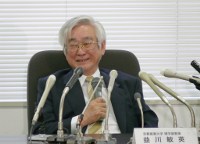 |
 |
|||||||||||||
|
|||||||||||||
|
|||||||||||||
|
Toshihide Maskawa is one of the most popular public figures in Japan at the moment. He has charmed many Japanese people with his humour and pure passion for the science that he showed at the press conference after he won the 2008 Nobel prize in physics, together with Yoichiro Nambu, professor emeritus at Chicago University, and Makoto Kobayashi, honorary professor emeritus at KEK. “We are very much surprised by all these requests for interviews with him, including the TV variety shows,” said the public relations officer at Kyoto Sangyo University. Of course, Maskawa has been having hectic days since last October. “I was able to take the first three days of the new year as holidays. Otherwise, somebody is always taking me around. But, I realise that this is my duty,” he said. From where he stands now, promoting the fun of science is his job. “I am happy to have this position, because not too many people have this opportunity.” “That was the only time when the physical interests of Kobayashi and mine crossed. I feel that was a sort of coincidence,” Maskawa said, looking back over the period when he wrote the very thesis which brought him and Kobayashi the Nobel Prize. In their work, they predicted the existence of more than six quarks – three were known but some scientists still had doubts even on the four-quark model at the time. “If I had called out 'who believes in the quarks?,' not too many scientists would have raise their hands back then,” said Maskawa. Both Maskawa and Kobayashi graduated from and earned their PhDs at Nagoya University. The theoretical particle physics group of Nagoya University was at the time conducting unique research under the Shoichi Sakata, where four-quark model was discussed as a matter of course. “We approached the CP violation issue from different viewpoints. From my understanding, Kobayashi got interested in CP violation from a new event found at Nagoya University by observing cosmic radiation using photographic plates. My approach was from the higher-order effect of the weak interaction. In connection with the four-quark model and from my interest in the higher-order effects of weak interaction, I noticed a paper by Glashow, Iliopoulos and Maiani in 1969 and called the attention of some of my colleagues to it. This reminded me of the four-quark model once again.” Maskawa and Kobayashi started working together spontaneously, and finished their paper in a month and a half. They started to study the CP violation in the electroweak unified gauge theory. First they had to determine how the left and right-handed components of the four quarks transform under the electroweak symmetry. There are three cases for each of left- and right-handed components: A) 4 = 2 + 2, B) 4 = 2 + 1 + 1, and C) 4 = 1 + 1 + 1 + 1. They had to consider nine cases in total. In all the cases except for case (A, B) where the left component is A) and the right is B), they saw that the CP violation could not occur if they take into account the freedom to arbitrarily choose the phases of the quark fields. The last case (A,B) was an exception. “I thought that it seemed to work and asked Kobayashi whether he agreed. Kobayashi put his head a little to one side and answered 'I will examine this in detail overnight.' He probably knew the result already, but answered like that for safety. The next day he told me, 'That case does not work since it predicts wrong sign for 9V/9A contradicting the experiment.' Without his denial, I would not have examined whether the six quark model would ever work.” Right after the announcement of 2008 Nobel Prize in physics, the International Linear Collider project was suddenly in the spotlight in Japan. “I am deeply moved that Japan became one of the partners in big international project like the ILC. When I wrote the paper on CP violation, Japan's high-energy physics community was like a toddler who had just start walking. Time has changed,” Maskawa said. Maskawa and Kobayashi's work helps to explain why all particles are not always symmetrical, including making a differentiation between particles and their antiparticles, which is critical to the universe's existence. But scientists are still in the quest of solving the mystery. The ILC will be a tool to take this quest one step further. “I am looking forward to seeing the ILC project realised.” -- Rika Takahashi
|
|||||||||||||
| © International Linear Collider |
